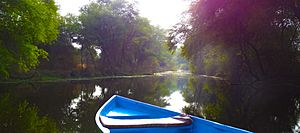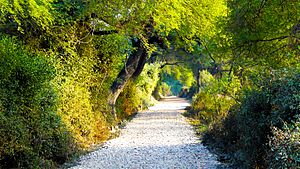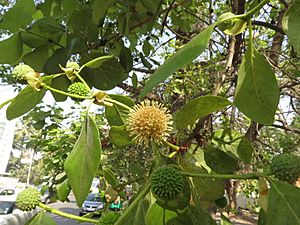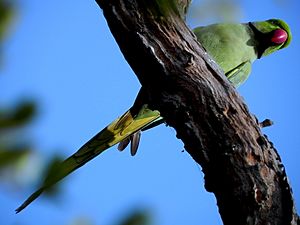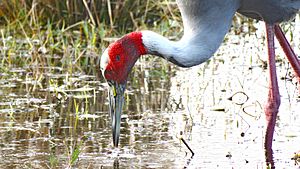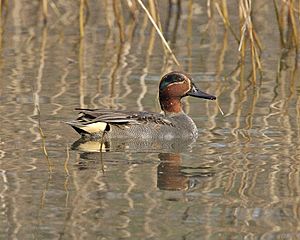Keoladeo National Park facts for kids
Quick facts for kids Keoladeo Ghana National Park |
|
|---|---|
|
IUCN Category II (National Park)
|
|
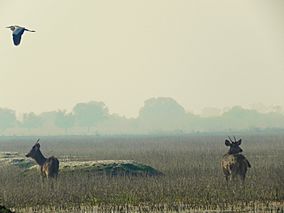
Keoladeo Ghana National Park, Bharatpur, Rajasthan, India
|
|
| Location | Bharatpur, Rajasthan, India |
| Nearest city | Bharatpur, Rajasthan |
| Area | 2,873 hectares (7,100 acres; 11.1 sq mi; 28.7 km2) |
| Established | 10 March 1982 |
| Visitors | 100,000 (in 2008) |
| Governing body | Rajasthan Tourism Development Corporation |
| UNESCO World Heritage Site | |
| Official name | Keoladeo National Park |
Keoladeo National Park, also known as Keoladeo Ghana National Park, is a famous bird sanctuary in Bharatpur, Rajasthan, India. It used to be called the Bharatpur Bird Sanctuary. This amazing place is home to thousands of birds, especially during the winter. Over 230 different kinds of birds live here all year round. Many bird watchers, called ornithologists, visit during the colder months to see them.
Keoladeo Ghana National Park is a special wetland area that was created and is managed by people. It is one of the national parks of India. The park helps protect Bharatpur from floods. It also provides places for village animals to graze. Long ago, it was mainly used as a hunting ground for waterfowl.
The park covers about 29 square kilometers (11 square miles). Locals call it Ghana, which means 'thicket'. It has different types of areas like dry grasslands, forests, swamps, and wetlands. These varied habitats are home to 366 bird species, 379 plant species, 50 types of fish, and many other animals like snakes, lizards, frogs, and turtles.
Every year, thousands of migratory waterfowl visit the park to spend the winter and raise their young. This sanctuary is one of the best bird areas in the world. It is famous for both birds that live there all the time and birds that visit from far away. Sadly, the rare Siberian crane used to spend winters here, but they no longer do. Peter Scott, who started the World Wildlife Fund, said that Keoladeo National Park is one of the world’s best places for birds.
Contents
History of Keoladeo National Park
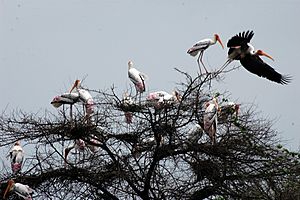
This bird sanctuary was created about 250 years ago. It is named after a temple dedicated to Lord Shiva, called Keoladeo, which is inside the park. Originally, the area was a natural dip in the land. It became flooded after a dam called the Ajan Bund was built. This dam was constructed by Maharaja Suraj Mal, who ruled the princely state of Bharatpur between 1726 and 1763. The dam was built where two rivers, the Gambhir and Banganga, meet.
The park used to be a hunting ground for the Maharajas of Bharatpur, a tradition that started around 1850. Special duck hunts were held every year to honor the British viceroys. For example, in one hunt in 1938, over 4,273 birds like mallards and teals were hunted by Lord Linlithgow, who was the Viceroy of India at the time.
The park officially became a national park on March 10, 1982. Before that, it was the private duck hunting area of the Maharaja of Bharatpur since the 1850s. It was made a bird sanctuary on March 13, 1976. In October 1981, it became a Ramsar Site under the Wetland Convention, which protects important wetlands. The last big hunt took place in 1964, but the Maharaja kept hunting rights until 1972.
In 1985, Keoladeo National Park was recognized as a World Heritage Site because of its global importance. It is managed by the State of Rajasthan in India. In 1982, grazing by local farmers' cattle was stopped in the park. This led to some disagreements between the farmers and the government.
Geography of the Park
Keoladeo National Park is located in eastern Rajasthan, India. It is about 2 kilometers (1.2 miles) southeast of Bharatpur city and 50 kilometers (31 miles) west of Agra. The park covers an area of about 29 square kilometers (11 square miles). About one-third of the park is wetland, which means it's covered in water.
The higher areas of the park have grasslands with tall grasses and scattered trees and shrubs. Dykes, which are like small walls, divide the wetland into ten sections. Each section has gates to control the water level, which is very important for the birds and other wildlife.
Flora and Fauna: Plants and Animals
The park is in a semi-dry area, but it has a lot of plants, which is why it's called 'Ghana' (meaning 'thicket'). The main types of plants are tropical dry forest trees mixed with dry grasslands where forests have been cleared. Besides the wetlands, which are managed by people, much of the park is covered by medium-sized trees and shrubs.
Animals of Keoladeo National Park
Many different animals live here. You might see the common monitor lizard, Indian porcupine, and the bi-colored leaf-nose bat. Some types of snakes found in the park include kraits, cobras, and Russell’s vipers.
Tiny creatures like worms, insects, and snails, called macro invertebrates, live mostly in the water. They are a very important food source for many fish and birds. They are a big part of the park's food chain and help the ecosystem work well. There are also many land insects, which are good for land birds that eat them.
The park has 43 different kinds of fish. The fish population is very important because they are a major food source for many birds. Keoladeo National Park also has a rich variety of mammals, with 27 different species identified.
Keoladeo National Park is known as a "bird paradise" because more than 370 bird species have been seen there! The park is important for two main reasons:
- It's a stopping point for migratory waterfowl that arrive in India before flying to other regions.
- Waterfowl gather here before flying back to their breeding grounds in the west.
- It's also a winter home for huge groups of waterfowl. It used to be the only regular winter home in India for the critically endangered Siberian crane.
Visiting Keoladeo National Park
Because it's one of Asia's best places for bird watching, more than 100,000 people visit the park every year. Visitors range from serious birdwatchers to school children. About 45,000 of these visitors are from other countries. The park is open from sunrise to sunset all year round.
You can find places to eat and stay inside the park. Besides regular tourism activities and self-guided bird watching tours, visitors can also take luxury train tours. Some luxury trains, like the Palace on Wheels, include Bharatpur Bird Sanctuary in their travel plans.
Related pages
Images for kids
-
Great egret at Keoladeo Ghana National Park
-
Knob-billed duck alongside Eurasian coot
-
Oriental magpie-robin in Keoladeo National Park
See also
 In Spanish: Parque nacional de Keoladeo para niños
In Spanish: Parque nacional de Keoladeo para niños



